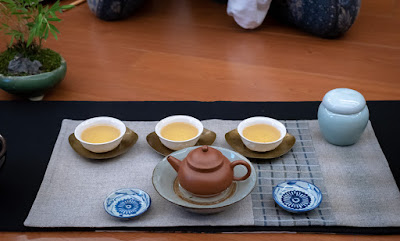The following Chaxi finds its inspiration in the above painting by Shen Shichong (1602-1633) in the year year 1625 (Ming dynasty). It is from the album of "Twelve scenes from the Jiao garden", a garden that belonged to Wang Shimin, a very famous painter of the orthodox school.
We see two men side by side outside a large house and next to a lotus pond. The men are looking in the same direction. They are quietly talking and gazing at the pond. This painting bring art and art of life together. Isn't that the ideal way to meet with a friend? The place is covered against the sun and the rain, and the view on the pond exudes peace and beauty.
So, with this painting in mind, I asked Christopher to join me here for tea.
Here we are in the Fang-Jian study of the Lin gardens in Banciao! The resemblance is amazing!
Old and large banyan trees add their shade, but the late afternoon light is vivid nonetheless.
I have brought my late Qing dynasty cup, my late Ming Anping jar, a small late Qing celadon plate, my old bamboo basket and 2 thrown ceramic, woodfired cups by David Louveau. They kept the Xiaguan shu puerh of 2001 I brewed warm and gave it life and texture.
I last saw Christopher three years ago, but we reconnected very quickly. I credit the tea and the relaxed scenery for the ease of our conversation. At one point, I mentioned that tea class isn't like a sect. He then shared that he didn't always feel comfortable when learning tea in Taiwan several years ago. Some of his previous teachers insisted so much on the meditative part of tea that you have to prepare tea their way, at their (slow) speed, with certain movements, that he felt that all these rules didn't help him, but were in the way of enjoying the tea moment.
So, he must have felt vindicated to see me prepare my puerh in a Ming dynasty manner: few leaves, a large teapot and large cups. This style is the most practical when you're not brewing at home, but on the go. And since Christopher is working overseas most of the time, I wanted to show him that he can still enjoy good tea, even if the water isn't great and with a limited amount of wares.
This shows that this Chaxi doesn't just find its inspiration in the aesthetics of the Ming painting, but that it also connects more deeply to how tea was prepared at that time. There's a lot we can learn from the past! It guides us as a light in the dark!
Thank you for this memorable afternoon by the lotus pond.
2024 vs 2023 Tea Encounter YiShanMo Gushus!
2 hours ago































































